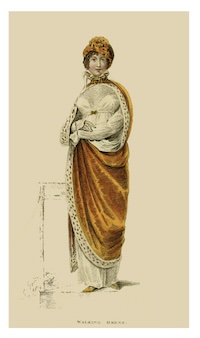Five years ago while I was caring for my dad and had to sit with him in front of the TV for hours at a time, I wasn’t able to write stories and got very bored. (Yay Buckeyes! We love Alex Trebek!) Seriously, I wish I could do that with him now. He passed away in 2021.
One day I discovered a website with all of the Ackermann’s Repository of the Arts volumes from 1809-1828 available to download. Wow! Thanks for doing that, Internet Archive! (I just made a donation.) The issues are all fascinating, but I was particularly interested in the fashions. To find the fashions—of which there are four per month—you have to scroll through the rest of the issue. Which is time-consuming. I mean, I just wanted to scroll through all the dresses!
So it occurred to me that I could screen-shoot the fashions and keep them in a folder and maybe find something to do with them later. If I’d had anything more important to do, I might not have bothered. I mean, there are four fashions per issue, twelve issues per year, and twenty years of issues. That’s 480 fashions! But that part was kind of mindless and I could shout out “Go Michigan State!” every once in a while, and give my dad the impression I was paying attention.
When that was accomplished, I put on my thinking cap and tried to figure out a way to make these more accessible. Make a Powerpoint presentation? A Word document? A website? That’s when it occurred to me that I could put them in a book. E-book. Print. Whatever. Such a book would be useful to me and I figured it would be so to others too. And… why not add the descriptions as well? Of course, that would mean typing pages and pages of descriptions. Talk about time-consuming! But… I’m a fast typist and I didn’t have anything more important to do, so that’s what I did. I learned I could type and half-listen to Wheel of Fortune at the same time. A useful skill to have, don’t you agree?
More screen-shooting, this time the descriptions. Organizing the fashions and descriptions into folders, then Scrivener. Typing and more typing. Sizing the fashion scans. Then copying and pasting into Vellum. Spell-checking (and learning there are all different spellings for the words in those descriptions). And creating a cover.
By the time I got that far, it had occurred to me to add a few pages that might be useful to authors and readers and costume designers and whoever else purchased the book. So I added additional fashion comments, color coding pages, and historical contexts for each year.
The pages added up fast. To almost 1400! That’s quite a book, even more pages than one of Gabaldon’s Outlander books. I discovered I couldn’t upload a print book that size to Amazon KDP. So I checked out Ingram Spark and discovered that even with them, I’d have to break the books up into four volumes. E-X-P-E-N-S-I-V-E! But for those who prefer print books, they are available, at least.
No problem with the e-book, however. I was able to upload the entire book for people to use on their phones or tablets for a reasonable price.
And then it occurred to me that some readers might prefer to just flip through the fashions without all the text. Creating an image-only version was easy by that time. So there’s a single print book as well as an e-book of this one too.
Which means I ended up with SEVEN different versions! Readers can pick the one or more that works for them.
Ackermann’s Repository 1809-1828: the E-book
Frankly, I prefer reading on my phone. I don’t have to carry a Kindle around with me, nor a print book. My purse is heavy enough already. So my favorite version (and I have all of them) is the E-book. The comprehensive one. It’s easy to use the Table of Contents to flip to the year I’m looking for, and I can use the original description to help me with the description of the dress in my story. I have it with me wherever I am. I can open it up in my phone or my computer (whichever is most convenient). For this reason alone, I’m glad I went through all that effort. And because I think of my dad at the same time too.
All Regency Authors Need This!
Seriously. Am I wrong?
All seven versions and buy links can be found here. You might possibly find the print books at discounted prices at my Etsy shop. Or scan the QR code below for the Amazon buy link for the e-book. I hope you find it as helpful and entertaining as I do. Let me know!
Susana Ellis is a retired teacher, part-time caregiver, sewist, cook, and fashion print collector. Lifelong reading and a fascination with history led her to writing historical romances. She is one of the original Bluestocking Belles and a member of Regency Fiction Writers and the Maumee Valley Romance Authors Inc.











